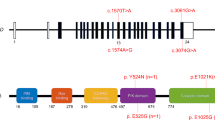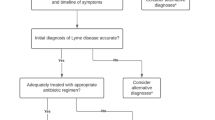Abstract
Background
To clarify the impact of T cell responses towards enteric antigens for chronic intestinal inflammation, we determined T helper 1 reactivity towards conserved Escherichia coli proteins in patients with Crohn’s disease (CD) and healthy individuals and patients with ankylosing spondylitis (AS), who also often show microscopic inflammatory lesions within the gut or even develop overt inflammatory bowel disease.
Methods
We determined the frequency of IFNγ+CD40L+ cells/CD4+ T cells after stimulation of whole blood with pools of E. coli proteins.
Results
The E. coli-specific Th1 response was significantly reduced in CD patients and to a lower extent also in AS patients.
Conclusions
E. coli is a target for polyclonal Th1 responses in healthy individuals. The impairment of these responses in CD and AS patients might be due to recruitment of enterobacteria-specific Th1 cells to the gut or might reflect inadequate priming of adaptive immune response.







Similar content being viewed by others
References
Duchmann R, Zeitz M. Crohn's disease: current pathogenetic paradigms. In: Mestecky J, Bienenstock J, Lamm M, Strober W, McGhee J, Mayer L, editors. Mucosal immunology. San Diego: Elsevier; 2005. p. 1265–86.
Karp LC, Targan SR. Ulcerative colitis: evolving insights into pathogenesis. In: Mestecky J, Bienenstock J, Lamm M, Strober W, McGhee J, Mayer L, editors. Mucosal immunology. San Diego: Elsevier; 2005. p. 1255–64.
Mielants H, Veys EM, Cuvelier C, De Vos M, Goemaere S, De Clercq L, et al. The evolution of spondyloarthropathies in relation to gut histology. II. Histological aspects. J Rheumatol. 1995;22:2273–8.
Mielants H, Veys EM, Cuvelier C, De Vos M, Goemaere S, De Clercq L, et al. The evolution of spondyloarthropathies in relation to gut histology. III. Relation between gut and joint. J Rheumatol. 1995;22:2279–84.
Rudwaleit M, Baeten D. Ankylosing spondylitis and bowel disease. Best Pract Res Clin Rheumatol. 2006;20:451–71.
Danoy P, Pryce K, Hadler J, Bradbury LA, Farrar C, Pointon J, et al. Association of variants at 1q32 and STAT3 with ankylosing spondylitis suggests genetic overlap with Crohn's disease. PLoS Genet. 2011;6:e1001195.
Lakatos PL, Fischer S, Lakatos L, Gal I, Papp J. Current concept on the pathogenesis of inflammatory bowel disease-crosstalk between genetic and microbial factors: pathogenic bacteria and altered bacterial sensing or changes in mucosal integrity take “toll”? World J Gastroenterol. 2006;12:1829–41.
Cong Y, Weaver CT, Lazenby A, Elson CO. Bacterial-reactive T regulatory cells inhibit pathogenic immune responses to the enteric flora. J Immunol. 2002;169:6112–9.
Powrie F, Leach MW, Mauze S, Caddle LB, Coffman RL. Phenotypically distinct subsets of CD4+ T cells induce or protect from chronic intestinal inflammation in C. B-17 scid mice. Int Immunol. 1993;5:1461–71.
Powrie F, Leach MW, Mauze S, Menon S, Caddle LB, Coffman RL. Inhibition of Th1 responses prevents inflammatory bowel disease in scid mice reconstituted with CD45RBhi CD4+ T cells. Immunity. 1994;1:553–62.
Strober W, Fuss IJ, Blumberg RS. The immunology of mucosal models of inflammation. Annu Rev Immunol. 2002;20:495–549.
Liu ZJ, Yadav PK, Su JL, Wang JS, Fei K. Potential role of Th17 cells in the pathogenesis of inflammatory bowel disease. World J Gastroenterol. 2009;15:5784–8.
Guarner F, Malagelada JR. Role of bacteria in experimental colitis. Best Pract Res Clin Gastroenterol. 2003;17:793–804.
Ryan P, Kelly RG, Lee G, Collins JK, O'Sullivan GC, O'Connell J, et al. Bacterial DNA within granulomas of patients with Crohn's disease—detection by laser capture microdissection and PCR. Am J Gastroenterol. 2004;99:1539–43.
Liu Y, van Kruiningen HJ, West AB, Cartun RW, Cortot A, Colombel JF. Immunocytochemical evidence of Listeria, Escherichia coli, and Streptococcus antigens in Crohn's disease. Gastroenterology. 1995;108:1396–404.
Kotlowski R, Bernstein CN, Sepehri S, Krause DO. High prevalence of Escherichia coli belonging to the B2+D phylogenetic group in inflammatory bowel disease. Gut. 2007;56:669–75.
Darfeuille-Michaud A, Neut C, Barnich N, Lederman E, Di Martino P, Desreumaux P, et al. Presence of adherent Escherichia coli strains in ileal mucosa of patients with Crohn's disease. Gastroenterology. 1998;115:1405–13.
Glasser AL, Boudeau J, Barnich N, Perruchot MH, Colombel JF, Darfeuille-Michaud A. Adherent invasive Escherichia coli strains from patients with Crohn's disease survive and replicate within macrophages without inducing host cell death. Infect Immun. 2001;69:5529–37.
Darfeuille-Michaud A, Boudeau J, Bulois P, Neut C, Glasser AL, Barnich N, et al. High prevalence of adherent-invasive Escherichia coli associated with ileal mucosa in Crohn's disease. Gastroenterology. 2004;127:412–21.
Duchmann R, May E, Heike M, Knolle P, Neurath M, Meyer zum Buschenfelde KH. T cell specificity and cross reactivity towards enterobacteria, bacteroides, bifidobacterium, and antigens from resident intestinal flora in humans. Gut. 1999;44:812–8.
Mertz AK, Daser A, Skurnik M, Wiesmuller KH, Braun J, Appel H, et al. The evolutionarily conserved ribosomal protein L23 and the cationic urease beta-subunit of Yersinia enterocolitica O:3 belong to the immunodominant antigens in Yersinia-triggered reactive arthritis: implications for autoimmunity. Mol Med. 1994;1:44–55.
Mertz AK, Ugrinovic S, Lauster R, Wu P, Grolms M, Bottcher U, et al. Characterization of the synovial T cell response to various recombinant Yersinia antigens in Yersinia enterocolitica-triggered reactive arthritis. Heat-shock protein 60 drives a major immune response. Arthritis Rheum. 1998;41:315–26.
Ergin A, Bussow K, Sieper J, Thiel A, Duchmann R, Adam T. Homologous high-throughput expression and purification of highly conserved E. coli proteins. Microb Cell Fact. 2007;6:18.
Frentsch M, Arbach O, Kirchhoff D, Moewes B, Worm M, Rothe M, et al. Direct access to CD4+ T cells specific for defined antigens according to CD154 expression. Nat Med. 2005;11:1118–24.
Best WR, Becktel JM, Singleton JW, Kern Jr F. Development of a Crohn's disease activity index. National Cooperative Crohn's Disease Study. Gastroenterology. 1976;70:439–44.
Garrett S, Jenkinson T, Kennedy LG, Whitelock H, Gaisford P, Calin A. A new approach to defining disease status in ankylosing spondylitis: the Bath Ankylosing Spondylitis Disease Activity Index. J Rheumatol. 1994;21:2286–91.
Choi YW, Kotzin B, Herron L, Callahan J, Marrack P, Kappler J. Interaction of Staphylococcus aureus toxin “superantigens” with human T cells. Proc Natl Acad Sci U S A. 1989;86:8941–5.
Hong SC, Waterbury G, Janeway Jr CA. Different superantigens interact with distinct sites in the Vbeta domain of a single T cell receptor. J Exp Med. 1996;183:1437–46.
Beninga J, Kropff B, Mach M. Comparative analysis of fourteen individual human cytomegalovirus proteins for helper T cell response. J Gen Virol. 1995;76(Pt 1):153–60.
Fernandez V, Andersson J, Andersson U, Troye-Blomberg M. Cytokine synthesis analyzed at the single-cell level before and after revaccination with tetanus toxoid. Eur J Immunol. 1994;24:1808–15.
Rudwaleit M, Siegert S, Yin Z, Eick J, Thiel A, Radbruch A, et al. Low T cell production of TNFalpha and IFNgamma in ankylosing spondylitis: its relation to HLA-B27 and influence of the TNF-308 gene polymorphism. Ann Rheum Dis. 2001;60:36–42.
Ogura Y, Imamura Y, Murakami Y, Takesue Y, Yokoyama T, Sueda T, et al. Intracellular cytokine patterns of peripheral blood T cells as a useful indicator of activeness of Crohn's disease. Hiroshima J Med Sci. 2005;54:1–8.
Raddatz D, Bockemuhl M, Ramadori G. Quantitative measurement of cytokine mRNA in inflammatory bowel disease: relation to clinical and endoscopic activity and outcome. Eur J Gastroenterol Hepatol. 2005;17:547–57.
Fuss IJ, Neurath M, Boirivant M, Klein JS, de la Motte C, Strong SA, et al. Disparate CD4+ lamina propria (LP) lymphokine secretion profiles in inflammatory bowel disease. Crohn's disease LP cells manifest increased secretion of IFN-gamma, whereas ulcerative colitis LP cells manifest increased secretion of IL-5. J Immunol. 1996;157:1261–70.
Annunziato F, Cosmi L, Santarlasci V, Maggi L, Liotta F, Mazzinghi B, et al. Phenotypic and functional features of human Th17 cells. J Exp Med. 2007;204:1849–61.
Marks DJ, Harbord MW, MacAllister R, Rahman FZ, Young J, Al-Lazikani B, et al. Defective acute inflammation in Crohn's disease: a clinical investigation. Lancet. 2006;367:668–78.
Smith AM, Rahman FZ, Hayee B, Graham SJ, Marks DJ, Sewell GW, et al. Disordered macrophage cytokine secretion underlies impaired acute inflammation and bacterial clearance in Crohn's disease. J Exp Med. 2009;206:1883–97.
Cho JH. The genetics and immunopathogenesis of inflammatory bowel disease. Nat Rev Immunol. 2008;8:458–66.
Cooney R, Baker J, Brain O, Danis B, Pichulik T, Allan P, et al. NOD2 stimulation induces autophagy in dendritic cells influencing bacterial handling and antigen presentation. Nat Med. 2010;16:90–7.
Riis L, Vind I, Vermeire S, Wolters F, Katsanos K, Politi P, et al. The prevalence of genetic and serologic markers in an unselected European population-based cohort of IBD patients. Inflamm Bowel Dis. 2007;13:24–32.
Seidelin JB, Broom OJ, Olsen J, Nielsen OH. Evidence for impaired CARD15 signalling in Crohn's disease without disease linked variants. PLoS One. 2009;4:e7794.
Brosbol-Ravnborg A, Hvas CL, Agnholt J, Dahlerup JF, Vind I, Till A, et al. Toll-like receptor-induced granulocyte-macrophage colony-stimulating factor secretion is impaired in Crohn's disease by nucleotide oligomerization domain 2-dependent and -independent pathways. Clin Exp Immunol. 2009;155:487–95.
Thomas GP, Brown MA. Genetics and genomics of ankylosing spondylitis. Immunol Rev. 2010;233:162–80.
Ge S, Danino V, He Q, Hinton JC, Granfors K. Microarray analysis of response of Salmonella during infection of HLA-B27-transfected human macrophage-like U937 cells. BMC Genomics. 2010;11:456.
Qian BF, Tonkonogy SL, Hoentjen F, Dieleman LA, Sartor RB. Dysregulated luminal bacterial antigen-specific T-cell responses and antigen-presenting cell function in HLA-B27 transgenic rats with chronic colitis. Immunology. 2005;116:112–21.
Acknowledgments
This study was supported by a grant from the Deutsche Forschungsgemeinschaft (SFB 633). We thank Ulrike Erben for critical discussion and reading of the manuscript.
Author information
Authors and Affiliations
Corresponding author
Rights and permissions
About this article
Cite this article
Ergin, A., Syrbe, U., Scheer, R. et al. Impaired Peripheral Th1 CD4+ T Cell Response to Escherichia coli Proteins in Patients with Crohn’s Disease and Ankylosing Spondylitis. J Clin Immunol 31, 998–1009 (2011). https://doi.org/10.1007/s10875-011-9575-x
Received:
Accepted:
Published:
Issue Date:
DOI: https://doi.org/10.1007/s10875-011-9575-x




